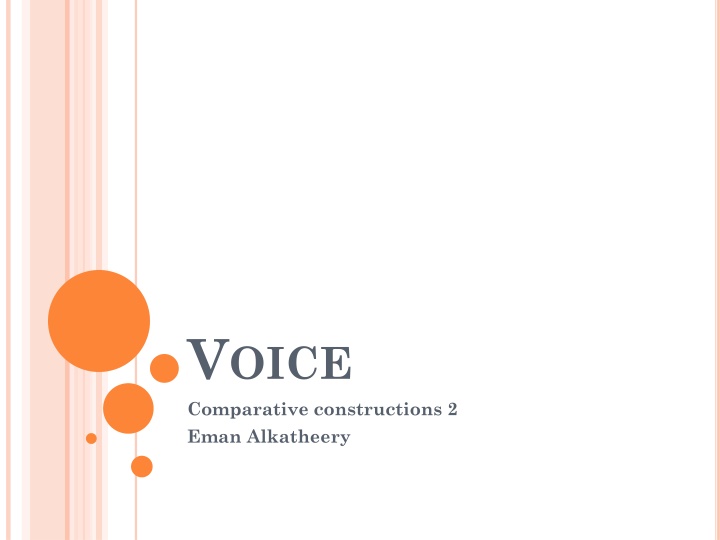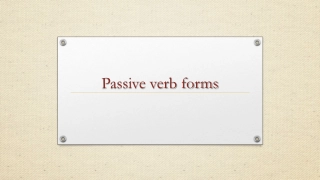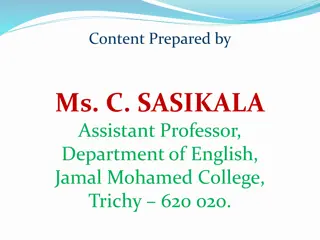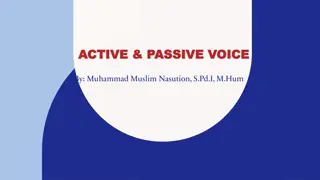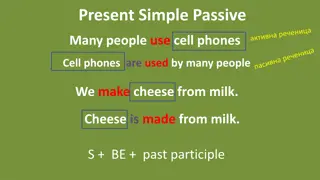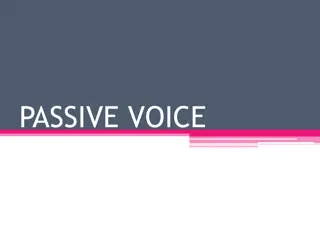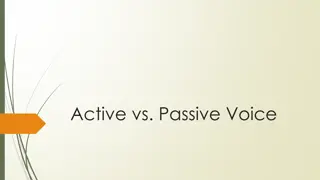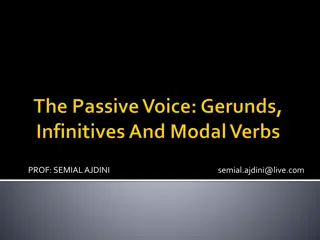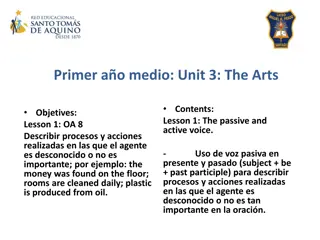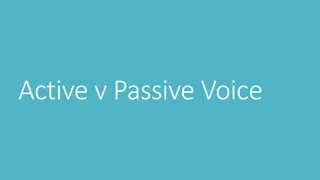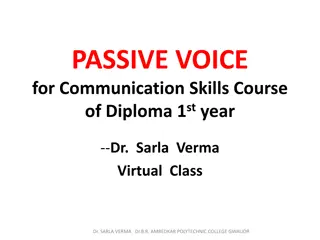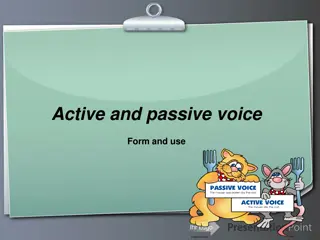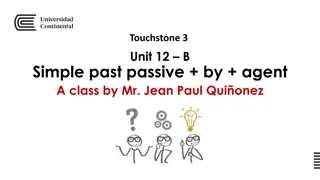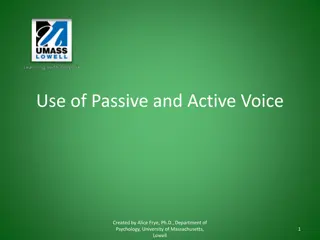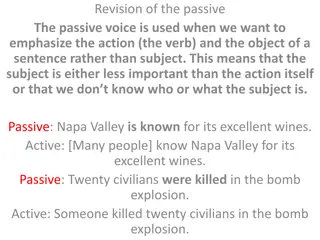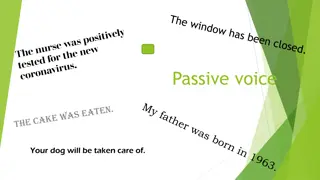Voice in Writing: Active vs Passive Voice
The differences between active and passive voice in writing, how to form them, and when to use each. Active voice emphasizes the doer of an action, while passive voice focuses on the receiver. Learn about sentence constructions and examples to enhance your writing clarity.
Download Presentation

Please find below an Image/Link to download the presentation.
The content on the website is provided AS IS for your information and personal use only. It may not be sold, licensed, or shared on other websites without obtaining consent from the author.If you encounter any issues during the download, it is possible that the publisher has removed the file from their server.
You are allowed to download the files provided on this website for personal or commercial use, subject to the condition that they are used lawfully. All files are the property of their respective owners.
The content on the website is provided AS IS for your information and personal use only. It may not be sold, licensed, or shared on other websites without obtaining consent from the author.
E N D
Presentation Transcript
VOICE Comparative constructions 2 Eman Alkatheery
VOICE a. John fired Mary b. Mary was fired by John
ACTIVE VOICE Active voice is preferable to passive in most nonscientific writing. Sentences in active voice are usually clearer and more direct than the long and complicated passive ones. In active voice, the subject of the sentence performs or causes the action expressed by the verb.
PASSIVE VOICE The subject in the passive voice does not refer to the person or thing responsible for the action. The difference between the passive and active voice lies in the form of the verb and the positions of the subject and the object.
VOICE a. John fired Mary b. Mary was fired by John Both sentences have the same meaning with a slight difference. The subject of the sentence is the center of interest. So, if we want to make a noun the center of interest, we put it in the subject position. In (a) our interest is fixed more on John, whereas in (b) our interest is Mary.
VOICE a. The tiger killed the hunter. b. The hunter was killed by the tiger. In the active voice, the subject of the verb carries out some action e.g. He hit the ball. In the passive voice, the subject of the verb is the receiver of the action or state indicated by the verb, and the doer of the action becomes the object of the preposition (by). The use of (by) phrase is optional. It can be omitted without affecting the meaning of the sentence.
PASSIVE VOICE To form the passive, add the various tenses of the auxiliary (be) to the main verb in the past participle. For example: a. David hired her. b. She was hired by David. a. Sara will sell the car next week. b. The car will be sold next week (by Sara)*. a. John is answering the question. b. The question is being answered by John.
VOICE FORMATION Tense Active Passive Present Do/ does Be/is/are/am done Past Did Was/were done Future Will do Will be done Present perfect Have/has done Have/has been done Past perfect Had done Had been done Future perfect Will have done Will have been done Past progressive Was/were doing Was/were being done Present progressive Am/is/are/be doing Am/is/are/be being done
PASSIVE VOICE In passive sentences, the receiver ,i.e., the person or object to whom the action is done occupies the subject position. Only transitive verbs can be used in the passive voice since they have one object or more. The direct and indirect objects can take the subject position. John sent a letter to sally. Sally was sent a letter by john. A letter was sent to sally by john.
WHEN TO USE THE PASSIVE VOICE 1. When the agent is unknown or cannot easily be stated He was captured in the battle. 2. When the subject is clear from the context. He was sent to prison for three years. 3. To avoid the frequent use of the pronoun I that may imply egotism. This point will be covered in our next lecture. 4. To show a great interest in the sufferer rather than the doer of the action. My brother was hit by a car.
WHEN TO USE THE PASSIVE VOICE 5. When the change to passive makes the transition from one part of a sentence to another easier. He spoke for an hour ,and his remarks were received by the audience with applause. 6. To express a frequent or habitual action. Millions of barrels of oil are exported annually. 7. In formal scientific writing. The experiment was conducted last year.
MIDDLE VOICE Verbs that can be either transitive or intransitive are called ergative verbs. In intransitive constructions, the agent (doer) is not mentioned. So, the intransitive construction of an ergative verb is said to be in a middle voice. 1. a. the boy broke the window. voice b. the window broke. voice c. the window was broken. voice 2. a. The plane flew. voice b. John flew the plane. voice c. The plane was flown. voice
THE PARTICIPLE A participle is a verb-form, which, in addition to its use in certain tenses of verbs, is used as an adjective. There are three tenses of the participle: the present, the past, and the present perfect. Hurrying, she ran to the classroom. The child had a scratched finger. Transitive verbs have both active and passive forms of the participle. Intransitive and linking verbs have only the active forms.
THE PARTICIPLE The studying group meets every week. (the group that meets to study together) (Present participle in the active) The anticipated problem was solved wisely. (the problem that the researchers anticipated) (Past participle in the passive) Past participle can be used as an adjective rather than a passive form. She was annoyed with the class. I'm worried about John. My teacher is pleased with my progress.
VOICE: NOUNS AND ADJECTIVES Some nouns and adjectives have an active or passive meaning. Employer: the one who employs. (active) Employee: the one who is employed. (Passive) Active Passive Examiner Examinee Creator Creature/Creation Trainer Trainee
VOICE IN ARABIC : . . . .
VOICE: ENGLISH AND ARABIC The Arabic passive voice is formed through case signs ( whereas the English passive voice is formed by the use of the different forms of the verb (to be) followed by the past participle. ),
PRACTICE Q1: Rewrite the following sentences to form the passive voice The boy writes poems. .. The girl drove the blue car. .. They have answered many questions. .. They will open a new restaurant. .. They offered him a job. .. The man showed us the house. ..
Q2: Indicate whether each of the following sentences is in the active voice, middle voice, or passive voice. The sun evaporates water. Water is evaporated (by the sun). . Water evaporates. .. Someone dropped a pen. .. A pen was dropped . A pen dropped. .. ..
: ) 3 ........................................... ........................................... ........................................... ........................................... ........................................... ........................................... ........................................... ........................................... ........................................... ........................................... ........................................... ........................................... ........................................... ...........................................
REFERENCES: Aartz, F. & Aartz, J. (1982). English syntactic structures. Oxford: Pergamon press. Al-Jarf, R. (1991). Contrastive Analysis for Translation Students. Riyadh: AL-Obeikkan Printing Press. Greenbaum, S. & Nelson, G. (2002). An introduction to English grammar. London: Longman. Lamberts, J. J. (1972). A short introduction to English grammar. New York: Mc Graw-Hill. Svartvik, J.(1966). On voice in the English verb. Paris: Mouton Wardhaugh, R. (2001). Understanding English grammar: a linguistic approach. New York: Blackwell. . : . .) 2012 ( .
: . ) ( 1 ) . (2) . (3) . (4) . (5) . (6) . : :............. :............. :............. :..................... : (7) ) 1 - 2 - 3 - 4 - ) : : : : 5 6 : :
